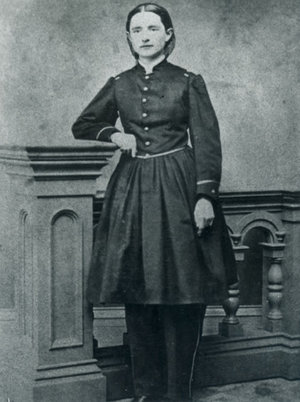Mary Edwards Walker was born in the town of Oswego, New York on November 26, 1832 to Alvah and Vesta Walker. Mary had four older sisters, Aurora, Luna, Vesta and Cynthia, and a younger brother, Alvah named after his father. The Walkers were a family before their time and they saw to it that their children received a formal education. All five of the Walker daughters became school teachers but Mary’s restless spirit led her to believe that she wasn’t contributing to society in a useful way.
Mary Edwards Walker decided to become a doctor and soon quit teaching. In June of 1855 she enrolled in the Syracuse Medical College. Mary chose Syracuse Medical College because it was not biased and women were accepted equally with men. She was the only woman enrolled in Syracuse at the time. Syracuse required that medical students attend three thirteen-week semesters of medical training. The cost for each semester was $55. Mary graduated from medical school when she was 23 and was the second woman in this country to become a doctor.
After she graduated Mary moved to Ohio to begin her medical practice. She was there only a short time when she met Dr. Albert Miller. After a whirlwind courtship, Mary Edwards Walker and Dr. Albert Miller were married. For her wedding, Mary chose to wear trousers and a man’s coat. Mary did not take Albert’s name; she preferred to be known as Dr. Walker. Eventually they moved to Rome, New York to open a medical practice but in the 1800s a woman doctor was unacceptable. Thus, Mary and Albert’s practice was doomed and soon had to close. Even though Mary and Albert’s marriage appeared to be happy in the beginning, the stress of a failing medical practice put a strain on the marriage. Mary divorced Albert in 1859 when she learned he was having an affair. Circumstances prevented their divorce being granted for another ten years.
Mary Edwards Walker began writing for “Sybil” magazine and became more involved in social causes; crusading against alcohol and tobacco. She became an early supporter of Women’s Rights and fervently championed the issue of dress reform. She supported Amelia Bloomer and adopted attire that emerged from the “Bloomer” movement. The Bloomer outfit consisted of a short, loosely draped dress over very loose pantaloons. This became Mary’s choice of dress forever after. Mary became involved in women’s liberation 100 years before it began. Her life was spent working to emancipate women from bondage.
When the Civil War began Mary traveled to Washington and applied to the United States Army for a commission to work as a doctor. She was rejected by the Medical Department. However, she worked in Washington as a volunteer at different camps where she could be of help. Mary received no compensation for her work. Eventually the Patent Office was turned into a hospital and she was permitted to work there as an assistant surgeon, again with no pay.
In 1862 Mary received an appointment as an assistant surgeon with the 52nd Ohio Infantry and served for almost two years in Fredericksburg and in Chattanooga following the Battle of Chickamauga. In 1863 she replaced the male medical officer and became the official surgeon of the Ohio Infantry regiment. She patterned her uniform in the fashion of men’s clothing, being trousers covered by a knee length overskirt and a tunic. Mary not only donned men’s clothing as a uniform but she carried two pistols under her coat. When she was reprimanded by General William Tecumseh Sherman for her selection of uniform she informed him what she wore was not important. Mary Edwards Walker was the first woman surgeon in the United States Army.
When the 52nd left Chattanooga Mary stayed behind to tend the sick and wounded and roamed the countryside caring for sick and hungry civilians. On April 10, 1864, after taking a wrong turn on the battlefield, she was taken prisoner by Confederate forces and accused of spying for the Union. She was convicted and spent four months in “Castle Thunder,” a prison in Richmond, Virginia. On August 12, 1864, her significance to the Union Army was made known when she was released along with twenty-four Union doctors for seventeen Confederate surgeons as part of a prisoner exchange. Mary Edwards Walker spent the duration of the Civil War working at a Kentucky women’s prison and a Tennessee orphan’s home.
Following the war Generals William Tecumseh Sherman and George Henry Thomas recommended Mary Edwards Walker for the Congressional Medal of Honor. On November 11, 1865, the day the United States celebrates as Veterans’ Day, President Andrew Johnson signed a bill to award the Medal of Honor to Mary Edwards Walker for her services during the Civil War and specifically for her service at the First Battle of Bull Run.
Mary Edwards Walker was paid the sum of $766.16 for her services during the Civil War. Later she was given $8.50 a month pension. That pension was eventually increased to $20. It is said that Mary’s pension was less than that received by some war widows.
In 1916 Congress revised the Medal of Honor standards to include only “actual combat with an enemy.” There had been decades of abuse of the Medal of Honor; it was being reproduced and sold and could be worn by anyone with money to make the purchase. A law was passed making it a crime to wear the Medal of Honor unless it was awarded for combat valor on the battlefield going above and beyond the call of duty. Even though Mary had gone “above and beyond the call of duty,” she had not fought in “actual combat with the enemy.” She, as well as Buffalo Bill Cody, was among 911 Medal of Honor awardees ordered to return their Medals. Mary refused and wore her Medal everyday until the day she died. It was even rumored that Mary’s Medal of Honor was rescinded because of her involvement with the women’s movement. That theory was was short lived because more than 900 men had also been asked to return their Medals of Honor. Congress insisted that the reason was to “…increase the prestige of the grant.”
This brave and courageous young woman was left scarred both physically and emotionally. She continued to fight for women’s rights for many years. In 1919 Mary Edwards Walker died alone and broke at the age of 87 proudly wearing her Medal of Honor. She was remembered more as being that “shocking female surgeon in trousers” than the brave patriot she was.
President Jimmy Carter posthumously restored Dr. Walker’s Medal of Honor on June 11, 1977. It is displayed in the women’s corridor of the Pentagon along with a plaque bearing her name.
Reference:
- Women in History; www.lkwdpl.org/wihohio/walk-mar






